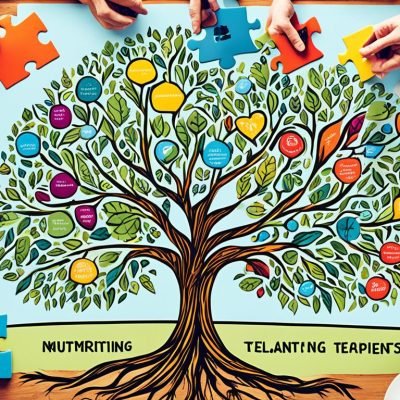Did you know that companies that invest in employee training and development experience 45% higher employee engagement levels compared to those that don’t?
In today’s fast-paced and competitive business environment, organizations understand the importance of nurturing their workforce through professional growth and skill enhancement. Employee training and development programs have become indispensable for attracting and retaining talent, fostering a culture of continuous learning, and driving organizational success.

Key Takeaways:
- Investing in employee training and development boosts employee engagement levels.
- Professional growth and skill enhancement are essential in today’s competitive business landscape.
- Employee training and development programs help attract and retain talent.
- A culture of continuous learning contributes to organizational success.
- Employee development programs drive employee motivation and engagement.
The Strategic Role of L&D
The Learning and Development (L&D) function plays a crucial role in the organization by managing the development of people and supporting key business priorities. It is instrumental in attracting and retaining talent through its focus on employee development and growth opportunities.
L&D helps organizations develop and enhance the capabilities of their employees, which is vital for retaining the value of human capital. By investing in learning and development initiatives, companies create a values-based culture, build an attractive employer brand, and drive motivation and engagement among employees.
Aligning L&D with the organization’s business strategy is paramount for driving success. By doing so, L&D ensures that the development opportunities provided to employees directly contribute to the achievement of strategic goals and objectives.
“L&D should align with the organization’s business strategy and co-own initiatives with business units and HR.”
By partnering with business units and HR, L&D can better understand the organization’s talent management needs and tailor development programs accordingly. This cooperative approach ensures that learning and development initiatives are aligned with the specific goals and objectives of the business units.
The Impact of Strategic L&D
“Strategic L&D contributes to attracting and retaining talent, developing people capabilities, creating a values-based culture, building an employer brand, and motivating and engaging employees.”
Strategic L&D has a significant impact on the organization’s overall talent management strategy. By offering robust learning and development opportunities, companies can attract top talent who value ongoing skill enhancement and professional growth. In turn, this helps in retaining high-performing employees who are eager to develop their skills and contribute to the organization’s success.
The role of L&D extends beyond attracting and retaining talent. It also contributes to the overall culture of the organization by fostering a commitment to continuous learning and development. By aligning development initiatives with the organization’s values, L&D helps establish a values-driven culture that attracts individuals who share those values.
“L&D plays a critical role in creating a values-based culture and building an attractive employer brand.”
Furthermore, L&D initiatives promote employee motivation and engagement. When employees have access to meaningful learning and development opportunities, they feel valued and are more likely to be engaged and committed to their work.
Aligning L&D with Business Strategy
For L&D to be truly effective, it must be aligned with the organization’s business strategy. This alignment ensures that employee development efforts are focused on the essential skills and competencies needed to drive business success.
“Aligning L&D with the business strategy ensures that development efforts are directly contributing to the organization’s goals and objectives.”
When L&D is aligned with the business strategy, it becomes an integral part of the organization’s talent management strategy. Learning and development initiatives are designed to address specific skill gaps and enhance critical capabilities that align with the organization’s strategic priorities.
To illustrate the strategic role of L&D, the table below highlights the alignment between L&D and business strategy, its impact on attracting and retaining talent, and supporting employee development.
| Alignment with Business Strategy | Attracting and Retaining Talent | Supporting Employee Development |
|---|---|---|
| Ensures L&D initiatives are aligned with the organization’s strategic goals and objectives. | Offers learning and development opportunities that attract top talent and demonstrate a commitment to employee growth. | Provides employees with development opportunities that enhance skills and capabilities aligned with strategic priorities. |
The L&D Function in Transition
The learning and development (L&D) function is continuously evolving to meet the changing needs of organizations. To strengthen this function, the ACADEMIES framework provides a comprehensive approach. This framework encompasses nine dimensions that enhance the effectiveness of the L&D function.
- Alignment with business strategy: L&D initiatives should align with the overall business strategy of the organization. This ensures that the learning and development activities support the achievement of strategic objectives.
- Co-ownership between business units and HR: A successful L&D function requires a collaborative partnership between business units and the HR department. By working together, they can ensure the alignment of L&D initiatives with the specific needs of the organization.
- Assessment of capability gaps: It is crucial to assess the current capabilities of employees to identify gaps and areas for improvement. By conducting a thorough assessment, organizations can tailor their learning and development programs to address these gaps effectively.
- Design of learning journeys: Instead of traditional training programs, organizations now focus on designing learning journeys. These journeys integrate various learning interventions and methods to create a holistic and engaging learning experience for employees.
- Execution and scale-up: Effective execution is key to the success of L&D initiatives. Organizations must secure stakeholder support, start with small-scale pilots, and gradually scale up the programs to maximize their impact.
- Measurement of impact on business performance: To demonstrate the effectiveness of L&D initiatives, organizations should establish metrics to measure their impact on overall business performance. This helps justify the investment in learning and development activities.
- Integration of L&D interventions into HR processes: L&D initiatives should be seamlessly integrated into HR processes to ensure their sustainability and long-term effectiveness.
- Enabling the 70:20:10 learning framework: The 70:20:10 learning framework recognizes that 70% of learning comes from on-the-job experiences, 20% from interaction with others, and 10% from formal training. Organizations should design their L&D programs accordingly to optimize learning outcomes.
- Utilizing learning technology applications: Learning technology applications, such as e-learning platforms and virtual reality simulations, can enhance the effectiveness and accessibility of learning and development initiatives.
“The ACADEMIES framework helps organizations strengthen their L&D function by focusing on key dimensions that align learning and development with business strategy, assess capability gaps, and design engaging learning journeys.”
Overview of the ACADEMIES Framework Dimensions
| Dimension | Description |
|---|---|
| Alignment with business strategy | Ensure L&D initiatives support the organization’s strategic objectives. |
| Co-ownership between business units and HR | Promote collaboration and shared responsibility between business units and HR for L&D initiatives. |
| Assessment of capability gaps | Evaluate employee capabilities to identify gaps and areas for improvement. |
| Design of learning journeys | Create comprehensive and engaging learning experiences for employees. |
| Execution and scale-up | Effectively execute and scale L&D initiatives for maximum impact. |
| Measurement of impact on business performance | Evaluate the impact of L&D initiatives on overall business performance using relevant metrics. |
| Integration of L&D interventions into HR processes | Seamlessly incorporate L&D initiatives into HR processes for sustainability. |
| Enabling the 70:20:10 learning framework | Design learning programs that leverage on-the-job experiences, interactions, and formal training for optimal learning outcomes. |
| Utilizing learning technology applications | Leverage technology to enhance the accessibility and effectiveness of learning and development activities. |
Alignment with Business Strategy
An effective L&D strategy is a crucial component of aligning the learning and development function with the overall business strategy of an organization. By aligning these two strategies, companies can maximize the impact of their L&D efforts and drive organizational success.
An L&D strategy that is closely aligned with the business strategy ensures that the learning initiatives and programs are directly linked to the company’s goals and objectives. It supports professional development, builds essential capabilities, and enhances the company culture. This alignment strengthens the relevance and effectiveness of the learning interventions, enabling employees to acquire the skills and knowledge required to drive business outcomes.
The first step in aligning the L&D strategy with the business strategy is to understand the talent and business strategies of the organization. This understanding helps identify the key capabilities needed to execute the business strategy successfully. By focusing on these essential capabilities, the L&D strategy can prioritize the development programs and interventions that will have the greatest impact on the organization’s growth and success.
Research shows that only 40 percent of companies currently have a learning strategy that is aligned with their business goals. This indicates that there is a significant opportunity for organizations to improve in this area and increase the alignment between their L&D and business strategies.
Risks of Misalignment
When there is a misalignment between the L&D strategy and the business strategy, organizations may face several risks:
- Wasted Resources: Learning interventions that are not aligned with the business strategy may not address the critical capability gaps or contribute to the achievement of the organization’s goals. This can result in wasted resources and a poor return on investment.
- Skills Gap: Misalignment can lead to a disconnect between the skills and knowledge acquired through learning initiatives and the skills needed to support the organization’s strategic direction. This skills gap can hinder the organization’s ability to adapt to market changes and innovate.
- Limited Impact: Without alignment, the L&D strategy may not have a significant impact on the desired business outcomes. This may result in a lack of credibility for the L&D function and a difficulty in securing support and resources for future initiatives.
To mitigate these risks and ensure effective alignment between the L&D and business strategies, organizations should establish clear communication channels and collaboration between key stakeholders, including business leaders, HR, and the L&D function. This collaboration ensures that the L&D initiatives are directly linked to the organization’s strategic priorities and supported by the necessary resources.
“Aligning the L&D strategy with the business strategy is essential for maximizing the impact of learning interventions and driving organizational success.”
An aligned L&D strategy not only supports the professional development and capability-building efforts but also contributes to creating a company culture that values learning and development. Employees are more likely to be engaged and motivated when they see that their development is closely tied to the organization’s success. This alignment fosters a continuous learning mindset and facilitates the retention and attraction of top talent.
By aligning the L&D strategy with the business strategy, organizations can create a cohesive and integrated approach to talent development that drives business results and positions them for long-term success.
| Benefits of Alignment | Risks of Misalignment |
|---|---|
|
|
Co-ownership between Business Units and HR
L&D strategies thrive when business units and HR collaborate in a strong partnership, fostering agile and responsive learning and development practices. By establishing a clear governance structure, leaders from both business units and HR can work hand in hand to define, prioritize, design, and secure funds for capability-building programs. This collaboration ensures that L&D initiatives align with the organization’s overall business goals and strategic direction.
The partnership between business units and HR brings several benefits to the forefront:
- Agility: By working together, business units and HR can swiftly adapt L&D programs to address emerging business needs, enabling organizations to stay ahead in the rapidly changing business landscape.
- Rapid Response: The collaborative nature of this partnership facilitates quick responses to evolving market demands, allowing employees to acquire the skills and knowledge necessary to thrive within their roles.
- Governance Structure: Establishing a governance structure ensures that both business units and HR have equal representation in decision-making processes, fostering transparency, accountability, and a balanced approach to capability-building initiatives.
- Capability-Building Programs: Co-ownership between business units and HR paves the way for designing and implementing effective capability-building programs. By leveraging the expertise from both sides, these programs can be tailored to specific business needs and employee development requirements.
Top business executives play a crucial role in embedding the learning function within the organizational culture. Their commitment to the vision of the L&D function helps create a holistic environment that values continuous learning and development.

| Key Advantages of Business and HR Partnership in L&D |
|---|
| The agility to adapt L&D programs to emerging business needs |
| Rapid response to evolving market demands |
| Establishment of a governance structure for transparency and accountability |
| Crafting effective capability-building programs |
Assessment of Capability Gaps and Estimated Value
Capability assessment plays a vital role in identifying and closing capability gaps within organizations. By developing a comprehensive competency or capability model aligned with the strategic direction of the company, businesses can effectively assess employee capabilities and determine areas in need of improvement. Through these assessments, organizations can prioritize closing capability gaps through targeted learning and development (L&D) interventions.
When conducting capability assessments, it is essential to define the desired competencies and skills that align with the organization’s strategic direction. By mapping out these competencies, organizations can identify gaps that hinder progress towards their strategic goals. Once these gaps are identified, closing them becomes a priority to ensure the organization is equipped with the necessary capabilities to succeed.
Capability assessments can be conducted using various tools and methodologies, such as self-assessments, performance evaluations, or competency-based interviews. These assessments provide valuable insights into individual and team capabilities and highlight areas where further development or training may be required.
Organizations can use competency models as a guide to evaluate employee skills, knowledge, and behaviors against specific criteria. These models outline the core competencies necessary for success within different roles or functions. By comparing employee capabilities to the competency model, organizations can identify strengths and areas for improvement, enabling targeted L&D initiatives to close capability gaps.
Assessment of capability gaps goes beyond identifying individual shortcomings; it also helps organizations estimate the value that closing such gaps can bring. By understanding the impact of closing specific capability gaps, organizations can prioritize their L&D efforts and ensure a return on investment (ROI) in terms of improved performance and enhanced organizational capability.
Example of a Capability Assessment Table:
| Capability | Current Level | Desired Level | Gap |
|---|---|---|---|
| Leadership | 3 | 5 | +2 |
| Communication | 4 | 4 | 0 |
| Problem Solving | 2 | 4 | +2 |
| Collaboration | 4 | 3 | -1 |
The table above provides a simplified example of a capability assessment. It allows organizations to assess the current level of each capability, set the desired level, and calculate the gap that needs to be closed through tailored L&D efforts.
Design of Learning Journeys
Traditional learning programs are being transformed into immersive learning journeys that prioritize continuous learning and the development of new capabilities and competencies. These learning journeys incorporate various learning interventions to cater to the diverse needs of employees, taking into account their busy schedules and individual learning preferences.
One key aspect of learning journeys is the inclusion of pre-and post-classroom learning activities. These activities provide employees with opportunities to prepare for and reflect on the content covered in classroom sessions, reinforcing their understanding and promoting deeper learning.
Digital learning is another crucial component of learning journeys, leveraging technology to deliver interactive and engaging learning experiences. This includes e-learning modules, virtual classrooms, and online communities where employees can access learning materials, collaborate with peers, and participate in discussions.
Fieldwork is often incorporated into learning journeys to provide practical application opportunities. Whether it’s shadowing experienced colleagues or engaging in hands-on projects, fieldwork allows employees to apply their newly acquired knowledge and skills in real-world contexts, enhancing their learning effectiveness.
Social learning is a powerful element within learning journeys, enabling employees to learn from each other and foster a collaborative learning culture. This can be facilitated through group discussions, peer-to-peer coaching, mentoring programs, and knowledge-sharing platforms.
Workshops and workshops-based training sessions are designed to promote active learning and skill development. These highly interactive sessions allow employees to engage in practical exercises, simulations, and role-plays to reinforce their learning and build their capabilities.
On-the-job mentoring is another valuable component of learning journeys. It provides employees with personalized guidance and support from experienced mentors who can share their knowledge, expertise, and insights. This type of mentoring helps employees apply their learning directly to their work and navigate challenges more effectively.
By incorporating these diverse learning interventions into learning journeys, organizations can create comprehensive and impactful learning experiences for their employees. This approach maximizes the effectiveness of employee development efforts by catering to different learning needs, promoting continuous learning, and ensuring practical application of new skills and knowledge.
| Benefits of Learning Journeys: | Components of Learning Journeys: |
|---|---|
|
|
Execution and Scale-up
Effective execution is a critical factor in achieving successful learning and development (L&D) strategies. To maximize the impact of L&D initiatives, stakeholder support is crucial throughout the execution process. Ongoing discussions and collaboration with key stakeholders help secure funding and sustain the program in the long run.
Starting with a small pilot program is a strategic approach to execution. A small pilot allows organizations to assess the program’s impact and make necessary adjustments before scaling it up. Furthermore, it enables cost-per-person reduction as economies of scale come into play.
Increase in Cost Efficiency as L&D Programs Scale Up
As the L&D program expands, an increase in participation leads to economies of scale. Costs per person decrease as the program reaches a larger audience, making it a more cost-effective solution for the organization. It allows companies to provide learning opportunities to a larger number of employees without significantly increasing the budget.
By focusing on outcome-based metrics, organizations can accurately measure the impact of the L&D program on business performance. These metrics enable the evaluation of the program’s effectiveness and alignment with business goals. It’s essential to establish clear performance indicators and track progress to ensure continuous improvement and optimize outcomes.
“The successful execution and scale-up of L&D initiatives require ongoing stakeholder support, careful assessment of impact, and the strategic use of outcome-based metrics.”
Table: Key Considerations for Execution and Scale-up
| Considerations | Explanation |
|---|---|
| Stakeholder Support | Engage key stakeholders and secure their support throughout the execution process. |
| Small Pilot Program | Start with a small-scale implementation to assess impact, make adjustments, and reduce cost-per-person. |
| Economies of Scale | As the program scales up, costs decrease per person, making it more cost-effective. |
| Outcome-based Metrics | Measure the impact on business performance using outcome-based metrics to evaluate effectiveness. |
Conclusion
Implementing an effective learning and development (L&D) strategy is crucial for employee growth and organizational success. By creating a learning and development strategy that aligns with the business strategy, organizations can foster employee growth and enhance their capabilities. This investment in professional development not only attracts and retains top talent but also builds a strong employer brand.
Furthermore, by co-owning L&D initiatives with business units and HR, companies can ensure that the L&D function is closely aligned with the organization’s strategic goals. This collaboration enables agile L&D practices, which can quickly respond to emerging business needs and foster continuous improvement.
Assessing capability gaps and designing effective learning journeys are essential components of a robust L&D strategy. By identifying where gaps exist and prioritizing the development of necessary skills, organizations can equip employees with the knowledge and abilities required to drive success. Embracing continuous learning through various interventions, including on-the-job mentoring and digital learning, ensures that employees can develop new competencies effectively.
Executing L&D initiatives and scaling them up are critical for achieving desired outcomes. Through stakeholder support and ongoing discussions, organizations can secure sufficient funding and sustain the L&D function. Starting with small pilot programs allows for impact assessment and cost optimization, benefiting from economies of scale as the initiatives expand. Measuring the impact on business performance using outcome-based metrics provides valuable insights into the effectiveness of L&D efforts.
In conclusion, a comprehensive and well-executed learning and development strategy is essential for organizational success. By investing in employee growth and professional development, companies can attract and retain top talent, develop a skilled workforce, build an employer brand, and ultimately achieve their business goals. Prioritizing L&D aligns the organization for long-term success in today’s dynamic and competitive landscape.







